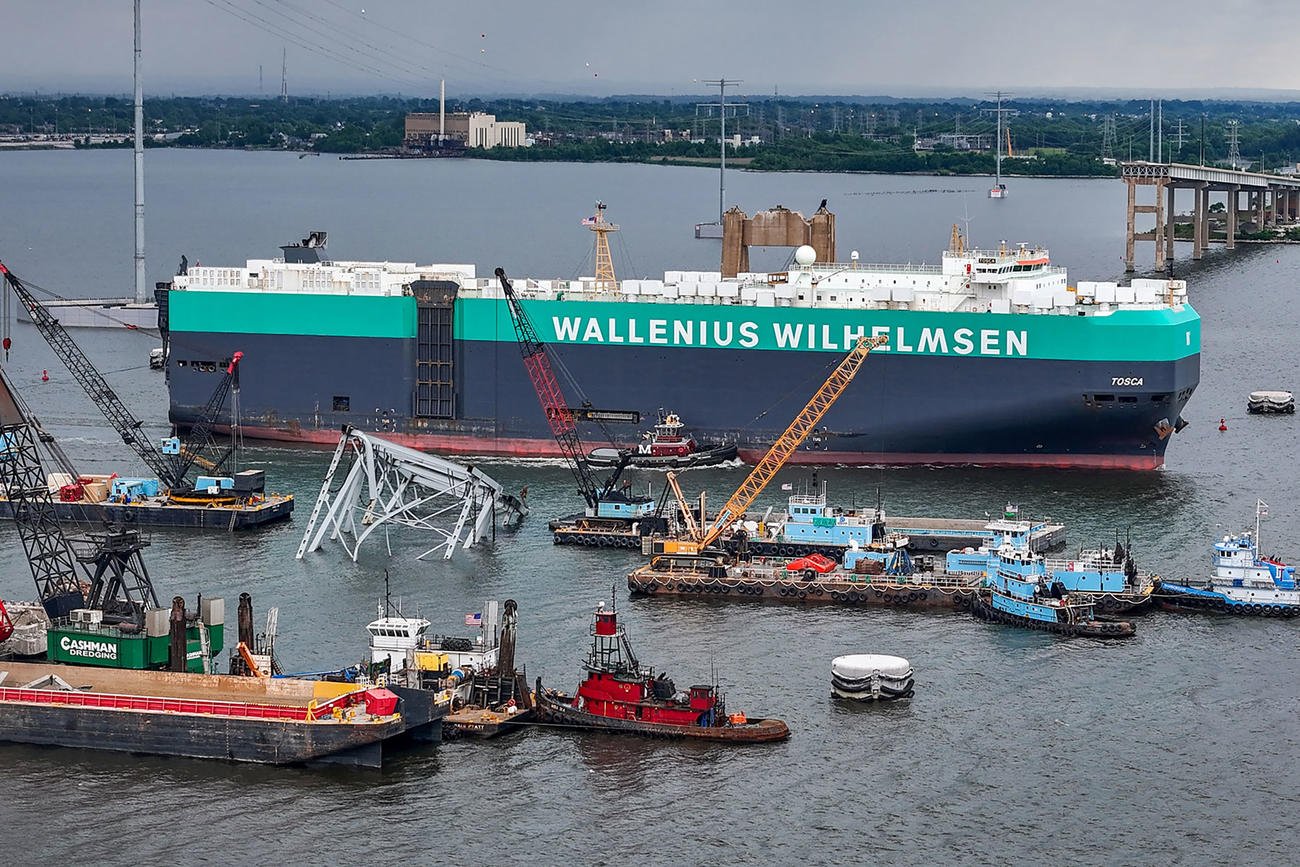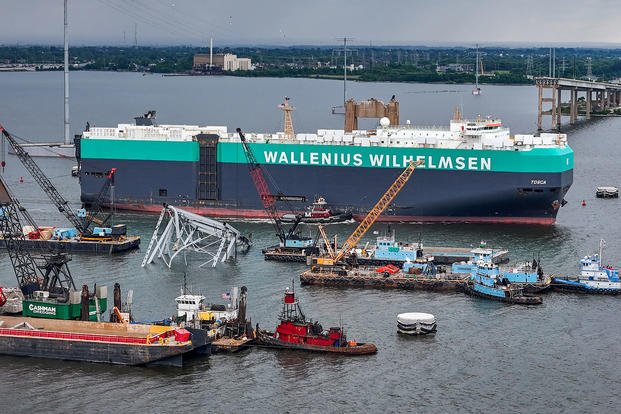

BALTIMORE — The Port of Baltimore’s shipping channel, in its entirety, is open for business as of Monday evening.
The navigable waterway had been at least partially blocked since March 26, when the 984-foot container ship Dali lost power and crashed into one of the Francis Scott Key Bridge’s support piers, knocking it over and killing six men who were filling potholes. The ship itself was lodged in the channel for nearly two months, in addition to 50,000 tons of debris from the bridge, which carried Interstate 695 over the Patapsco River.
“We’ve cleared the Fort McHenry Federal Channel for safe transit,” Col. Estee Pinchasin, Baltimore district commander of the Army Corps of Engineers, said in a statement about 6:30 p.m. Monday. “USACE will maintain this critical waterway as we have for the last 107 years.”
The reopening was forecast for sometime Monday, but it remained uncertain for most of the day whether crews would meet that deadline. In the early afternoon, Army Corps spokeswoman Cynthia Mitchell said the agency was awaiting final results from underwater surveys of wreckage on the riverbed that could get in the way of vessel traffic.
Crews swept the area with sonar, LIDAR and a magnetometer to “investigate any high spots, ensuring there’s no hazard to navigation,” Pinchasin said in an earlier statement.
Now, 11 weeks after the disaster, the 50-feet deep, 700-foot wide channel is fully open.
“Although the overarching goal to restore full operational capacity to the Federal Channel was successful, each day, we thought of those who lost their lives, their families, and the workers impacted by this tragic event,” Pinchasin said Monday evening. “Not a day went by that we didn’t think about all of them, and that kept us going.”
One day after the collapse, authorities cited opening the channel to shipping commerce as a priority. The Port of Baltimore has handled more automobiles than any U.S. port for 13 consecutive years, including more than 800,000 vehicles in 2023 alone. It is one of only seven U.S. ports to rank in the top 25 nationally for total tonnage, dry bulk tonnage, and container quantity received.
The shipping channel’s partial closure was a blow to local, as well as global, commerce. Last year, in April, the port’s public terminals handled 1 million tons of general cargo. This April, it handled a tiny fraction of that, just 1,822 tons. But since then, more and more ships have been able to call on Baltimore, and May’s numbers, not yet released, should show a substantial increase from April.
In the weeks following the collapse, the port’s cruise ship terminal became the headquarters of the Unified Command responding to the disaster, with Army Corps and Coast Guard personnel hurrying around below photos of tropical destinations that adorn the walls. Other key players in the response were the Maryland Transportation Authority, which was the bridge’s owner; Witt O’Brien’s, which represented Dali owner Synergy Marine; Maryland State Police and the Maryland Department of the Environment.
“We are proud of the unified efforts that fully reopened the Federal Channel to port operations,” Lt. Gen. Scott Spellmon, commanding general of Army Corps, said in the statement. “The partnerships that endured through this response made this pivotal mission successful.”
In the weeks and months following the collapse, some vessels were able to visit Baltimore via temporary channels. A 735-foot vessel arrived in Baltimore in late April, becoming the first container ship to arrive since the collapse and in late May, a 50-feet deep, 400-foot wide temporary channel was opened. That allowed large ships, guided by tugboats, to transit into Baltimore as crews continued to work to dredge and clear wreckage from beneath the surface.
Cruise activity resumed in late May, but cargo shipping was unlikely to immediately return to its previous level. Jonathan Daniels, director of the Port of Baltimore, has estimated that, conservatively speaking, it could take until late 2024 or early 2025 for a full return.
It took months to clear the channel, as authorities analyzed the channel via sonar technology, divers rigged large pieces of debris and cranes removed wreckage. The steel was ultimately taken to Tradepoint Atlantic via barge, where crews worked to cut it up for recycling.
The most dramatic move came May 13, when a large piece of Key Bridge atop the Dali was cut up using explosives. A week later, the Dali — its bow still gashed and mangled from the collision with the Key Bridge pier — was towed to the port, where it will remain for at least another week, before transiting to Norfolk, Virginia, for further repairs.
Crews lifted the final large piece of truss and concrete from the river June 4, but continued to pull out more wreckage from the mud line through the past week. After storms moved through the region in the middle of last week, skies cleared and crews lifted a 90-ton piece of residual wreckage from the federal channel Friday using the massive Chesapeake 1000 crane and a giant hydraulic salvage grab.
While vessel traffic can begin to return to normal, it will take much longer for automobile traffic on I-695 to do the same. The Key Bridge was one of three crossings of the Baltimore harbor and its collapse has sent more cars to the two tunnels underneath the Patapsco River. Meanwhile, trucks carrying hazardous materials — banned for safety reasons from the tunnels — have to drive around the city.
The state of Maryland is currently accepting bids for a builder for the new Key Bridge, which is expected to cost roughly $1.7 billion and open in 2028. Democratic President Joe Biden has vowed for the federal government to cover that cost in its entirety, though Congress has not yet passed legislation to ensure it’s 100% funded.
_____
(Baltimore Sun reporter Dillon Mullan contributed to this article.)
_____
©2024 The Baltimore Sun. Visit at baltimoresun.com. Distributed by Tribune Content Agency, LLC.
© Copyright 2024 The Baltimore Sun. All rights reserved. This material may not be published, broadcast, rewritten or redistributed.
